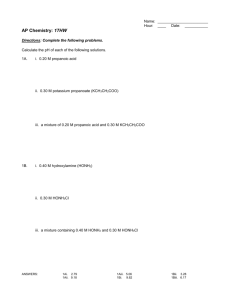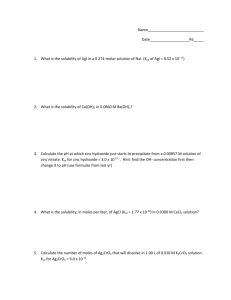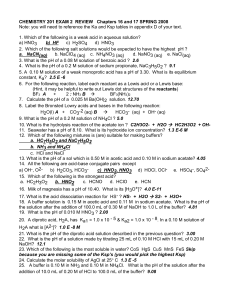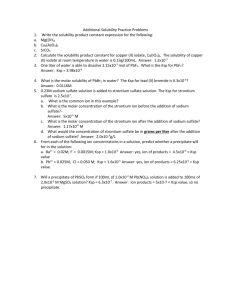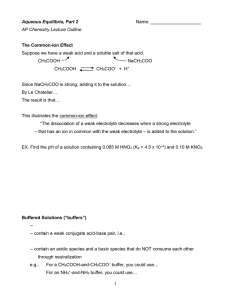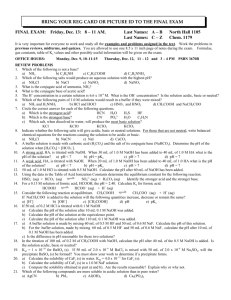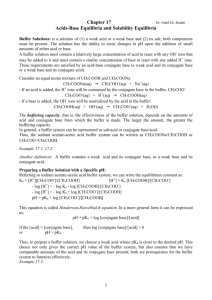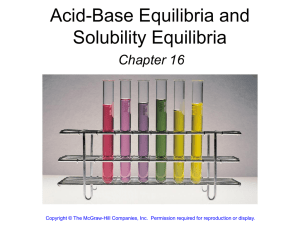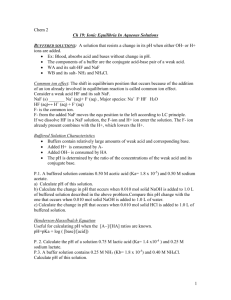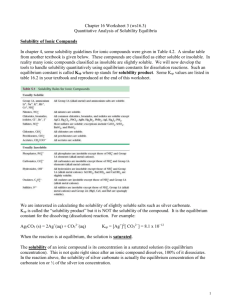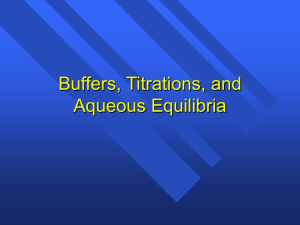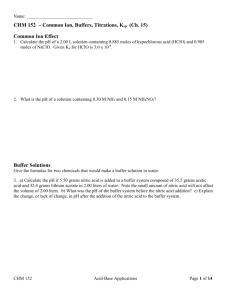Student Notes
advertisement
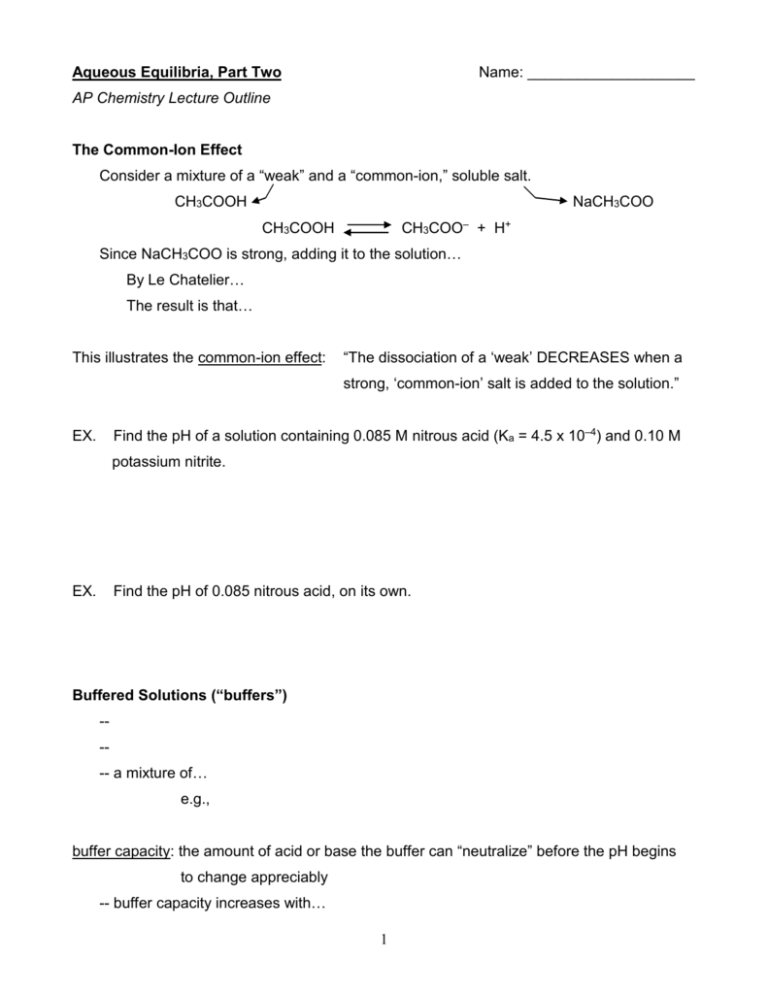
Aqueous Equilibria, Part Two Name: ____________________ AP Chemistry Lecture Outline The Common-Ion Effect Consider a mixture of a “weak” and a “common-ion,” soluble salt. CH3COOH NaCH3COO CH3COO– + H+ CH3COOH Since NaCH3COO is strong, adding it to the solution… By Le Chatelier… The result is that… This illustrates the common-ion effect: “The dissociation of a ‘weak’ DECREASES when a strong, ‘common-ion’ salt is added to the solution.” Find the pH of a solution containing 0.085 M nitrous acid (Ka = 4.5 x 10–4) and 0.10 M EX. potassium nitrite. EX. Find the pH of 0.085 nitrous acid, on its own. Buffered Solutions (“buffers”) ---- a mixture of… e.g., buffer capacity: the amount of acid or base the buffer can “neutralize” before the pH begins to change appreciably -- buffer capacity increases with… 1 EX. Find the pH of a buffer that is 0.12 M lactic acid, HC3H5O3 (Ka = 1.4 x 10–4) and 0.10 M sodium lactate. Addition of Strong Acids or Bases to Buffers -- Reactions between strong acids/bases and weak bases/acids proceed to completion. -- We assume the strong acid/base is completely consumed. -- When adding a “strong” to buffered solutions… (1) (2) EX. 2.00-L of a buffered solution of pH 4.74 contains 0.30 mol of acetic acid (Ka = 1.8 x 10–5) and 0.30 mol of sodium acetate. Calculate the pH after 0.040 mol of sodium hydroxide is added. Ignore volume changes. Acid-Base Titrations equivalence point: 2 Strong Acid – Strong Base Titrations pH curve for HCl titrated with NaOH Any indicator whose color change begins and ends along the vertical line is okay. -- phenolphthalein pH (pH 8.3-10.0) 7 -- methyl red (pH 4.2-6.0) mL of NaOH added EX. Find pH when 24.90 mL of 0.10 M nitric acid are mixed with 25.00 mL of 0.10 M potassium hydroxide. pH curve for CH3COOH titrated with NaOH Weak Acid – Strong Base Titrations The equivalence point is when, say, 50.0 mL of 0.10 M NaOH have been pH added to 50.0 mL of 0.10 M CH3COOH, but pH is > 7 at that point because... 7 mL of NaOH added 3 EX. Calculate the pH at the equivalence point if 40.0 mL of 0.0250 M benzoic acid (C6H5COOH, Ka = 6.3 x 10–5) are titrated with 0.050 M sodium hydroxide. EX. Calculate the pH when 10.0 mL of 0.080 M sodium hydroxide are added to 40.0 mL of 0.0250 M benzoic acid (C6H5COOH, Ka = 6.3 x 10–5). pH curve for H2CO3 pH Titration curves for polyprotic acids (e.g., H2CO3) look something like -- they have... 4 mL of base added Solubility Equilibria -- involve the dissolution or precipitation of “insoluble” salts Consider a saturated solution of a typical salt: For these cases, the solubility-product constant is equal to, respectively: Ksp expressions NEVER have denominators because… -- Ksp is the equilibrium constant between undissolved and dissolved ionic solute in a saturated aqueous solution. EX. Write the solubility-product constant expression for lead(II) chloride. EX. Copper(II) azide has Ksp = 6.3 x 10–10. Find the solubility of Cu(N3)2 in water, in g/L. EX. Find the solubility of zinc hydroxide (Ksp = 3.0 x 10–16) in a soln buffered at pH = 11.43. 5 Precipitation of Ions For BaSO4(s) Ba2+(aq) + SO42–(aq)... Ksp = [Ba2+] [SO42–] We could reach equilibrium from the left... or from the right... At any given time, the ion product Q = [Ba2+] [SO42–] If Q > Ksp... If Q < Ksp... If Q = Ksp... EX. Will a precipitate form from mixing 0.10 L of 8.0 x 10–3 M lead(II) nitrate and 0.40 L of 5.0 x 10–3 M sodium sulfate? selective precipitation: using the different solubilities of ions to separate them Say we want to separate the Ag+ and Cu2+ in a soln that contains both. -- Add HCl. CuCl2 is… AgCl is… -- Separate by... 6 Factors That Affect Solubility 1. For solids, as temperature increases, solubility... 2. common-ion effect Use Le Chatelier’s principle. For example, with... Ca2+(aq) + 2 F–(aq) CaF2(s) If you add Ca2+ or F–, 3. pH and solubility Compounds with anions exhibiting basic properties (e.g., Mg(OH)2 / OH–, CaCO3 / CO32–, CaF2 / F–) ___ in solubility as solution becomes more acidic. 4. presence of complex ions: metal ions and the Lewis bases bonded to them e.g., In a soln of AgCl, we have the equilibrium: If ammonia is added, we get… In general, the solubility of metal salts ___ in the presence of suitable Lewis bases (e.g., NH3, CN–, OH–) if the metal forms a complex ion with the bases. 7 Qualitative Analysis for Metallic Elements Steps: (1) aqueous solution containing “god-knowswhat” metal ions (2) Add HCl. insoluble chlorides (AgCl, Hg2Cl2, PbCl2) ppt out. Filter and test for a specific ion. Bubble H2S(g) in. acid-insoluble sulfides (CuS, Bi2S3, CdS, PbS, HgS, As2S3, Sb2S3, SnS2) ppt out. Filter and test for a specific ion. Add (NH4)2S. base-insoluble sulfides and hydroxides (Al(OH)3, Fe(OH)3, Cr(OH)3, ZnS, NiS, CoS, MnS) ppt out. Filter and test for a specific ion. Add (NH4)2PO4. insoluble phosphates (Ba3(PO4)2, Ca3(PO4)2, MgNH4PO4) ppt out. Filter and test for a specific ion. 8

